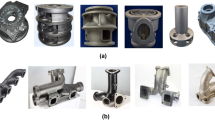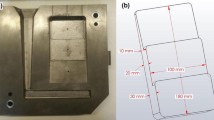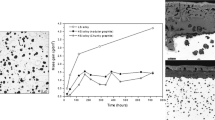Abstract
The present work evaluated the solidification pattern of 4.5%Si un-inoculated ductile iron by standard cooling curve analysis and addresses the effects of solidification cooling rate on as-cast structure as determined by metal mould versus sand mould and section size (3–15 mm). The 4.5%Si-alloyed ductile cast iron led to a large ΔTs eutectic interval (closer to 80 °C) and a very low undercooling (only 11% from ΔTs), while the temperature of the solidification end was more than 18 °C above the eutectic metastable temperature. The graphite amount was up to 65% lower in the metal mould and more depending on the section size. The metal mould versus green sand mould solidification increased nodule count (more than 30%) with a reduced effect of the increasing wall thickness, at higher rate of less than 15 μm size nodules and with 5–10% higher graphite nodularity. No free carbides were noticed in the green sand mould (inclusively at 3 mm section size), but up to 15% carbides in 6 mm thickness was remarked in the metal mould, with decreasing up to 5% for 12–15 mm thickness. In the present experimental conditions, 70–100% ferrite resulted in the green sand mould and 10–20% ferrite in the metal mould. It appears that solidification in metal mould of High-Si ductile cast iron was more sensitive to chemical composition, including minor (trace) elements than in the sand mould, documented as a high capacity to tolerate higher amounts of pearlite and carbide stabilizing elements. The results of the standard thermal (cooling curve) analysis are in agreement with the obtained structure of 4.5%Si ductile iron in the sand mould, but without the prediction of free carbides formation in the metal mould, being necessary to use ceramic cups at higher solidification cooling rate, especially for thin wall castings control.










Similar content being viewed by others
References
ISO 1083:2018 Spheroidal graphite cast irons—Classification. https://www.iso.org/standard/66643.html. Accessed on 13 April 2021.
EN 1563:2018 Founding—Spheroidal graphite cast irons. https://www.en-standard.eu/csn-en-1563-foundingspheroidal-graphite-cast-irons/. Accessed on 13 March 2021.
Riposan I, Chisamera M, Stan S. Factors influencing on the microstructure and mechanical properties of as-cast and heat treated 400–18 grade ductile cast iron. Int J Cast Metal Res. 2007;20(2):64–7.
Bai JX. Selection of raw materials and control of trace elements for production of high-quality SG iron. China Foundry. 2019;16(2):79–87. https://doi.org/10.1007/s41230-019-9006-9.
Stets W, Loblich H, Gassner G, Schumacher P. Solution strengthened ferritic ductile cast iron according DIN EN1563:2012–properties, production and application. In: Proceedings of the “Keith Millis” Symposium on Ductile Iron. Nashville, TN, USA. 15–17 Oct 2013. p. 283–292.
Dommaaschk C. Chances and limits of high silicon ductile iron. In: Proceedings of the WFO technical forum. Gauteng, Africa. 14–17 Mar 2017, Session 11, Plenary, Paper No. 2.
Huyan F, Larker R, Rubin P, Hedstrom P. Effect of solute silicon on the lattice parameter of ferrite in ductile irons. ISIJ Int. 2014;54(1):248–50.
Franzen D, Weiß P, Pustal B, Buhrig-Polaczek A. Modification of silicon microsegregation in solid solution strengthened ductile iron by alloying with aluminum. Int J Metalcasting. 2020;14(4):1105–14. https://doi.org/10.1007/s40962-020-00412-7.
Soivio K. Austempering experiments of production grade silicon solution strengthened ductile iron. Mater Sci Forum. 2018;925:239–45.
Alhussein A, Risbet M, Bastien A, Chobaut JP, Balloy D, Favergeon J. Influence of silicon and addition elements on the mechanical behavior of ferritic ductile cast iron. Mater Sci Eng A. 2014;605:222–8.
Weiss P, Riebisch M, Buhrig-Polaczek A. Improving the mechanical properties and impact toughness of high silicon ductile iron. Mater Sci Forum. 2018;925:304–10.
Riebisch M, Pustal B, Bührig-Polaczek A. Impact of carbide-promoting elements on the mechanical properties of solid-solution-strengthened ductile iron. Int J Metalcasting. 2020;14:365–74. https://doi.org/10.1007/s40962-019-00358-5.
Bauer B, Mihalic Pokopec I, Petric M, Mrvar P. Effect of Si and Ni addition on graphite morphology in heavy section spheroidal graphite iron parts. Mater Sci Forum. 2018;925:70–7.
Larranaga P, Asenjo I, Sertucha J, Suarez R, Ferrer I, Lacaze J. Effect of antimony and cerium on the formation of chunky graphite during solidification of heavy-section castings of near-eutectic spheroidal graphite irons. Metall Mater Trans A. 2009;40:654–61.
Górny M, Kawalec M, Gracz B, Tupaj M. Influence of cooling rate on microstructure formation of Si–Mo ductile iron castings. Metals. 2021;11:1634. https://doi.org/10.3390/met11101634.
Stan S, Riposan I, Chisamera M, Barstow M. Solidification pattern of silicon alloyed ductile cast irons. In: Proceedings of the 122nd AFS Metalcasting Congress. Fort Worth, TX, USA, 3–5 April 2018. p. 18–22.
Stan S, Riposan I, Chisamera M, Stan I. Solidification characteristics of silicon alloyed ductile cast irons. J Mater Eng Perform. 2019;28(1):278–86. https://doi.org/10.1007/s11665-018-3828-2.
Upadhya KG, Stefanescu DM, Lieu K, Yeager DP. Computer aided cooling curve analysis: principles and applications in metal casting. AFS Trans. 1989;97:61–6.
Barlow JO, Stefanescu DM. Computer-aided cooling curve analysis revisited. AFS Trans. 1997;104:349–54.
Stefanescu DM. Thermal analysis-theory and applications in metal casting. Int J Metalcasting. 2015;9(1):7–22.
Emadi D, Whiting LV, Nafisi S, Ghomashchi R. Applications of thermal analysis in quality control of solidification processes. J Therm Anal Calorim. 2005;81:235–42.
Dioszegi A, Svensson IL. On the problems of thermal analysis of solidification. Mater Sci Eng A. 2005;413–414:474–9.
Erbaş KC. A new baseline for the Newtonian thermal analysis of casting: two-capacitive system baseline. J Therm Anal Calorim. 2015;119(1):183–9.
González-Rivera C, Harrup A, Aguilar C, Amaro-Villeda A, Ramirez-Argaez M. Determination of the latent heat of fusion and solid fraction evolution of metals and alloys by an improved cooling curve analysis method. J Therm Anal Calorim. 2020;140:1825–36. https://doi.org/10.1007/s10973-019-08904-3.
Djurdjevic MB, Sokolowski JH, Odanovic Z. Determination of dendrite coherency point characteristics using first derivative curve versus temperature. J Therm Anal Calorim. 2012;109:875–82.
Xu JF, Liu F, Zhang D, Jian ZY. An analytical model for solidification of undercooled metallic melts. J Therm Anal Calorim. 2015;119:273–80.
Sparkman D. Microstructure by Thermal Analysis. AFS Trans. 2011;119:413–9.
Kakitani R, de Gouveia GL, Garcia A, Cheung N, Spinelli JE. Thermal analysis during solidification of an Al–Cu eutectic alloy: interrelation of thermal parameters, microstructure and hardness. J Therm Anal Calorim. 2019;137:983–96. https://doi.org/10.1007/s10973-018-07992-x.
Malekan M, Shabestari SG. Computer-aided cooling curve thermal analysis used to predict the quality of aluminum alloys. J Therm Anal Calorim. 2011;103(2):453–8.
Farahany S, Ourdjini A, Idris MH. The usage of computer-aided cooling curve thermal analysis to optimize eutectic refiner and modifier in Al–Si alloys. J Therm Anal Calorim. 2012;109:105–11.
Farahany S, Ourdjini A, Idrsi MH, Shabestari SG. Computer-aided cooling curve thermal analysis of near eutectic Al–Si–Cu–Fe alloy. J Therm Anal Calorim. 2013;114:705–17.
Mostafapoor S, Malekan M, Emamy M. Thermal analysis study on the grain refinement of Al–15Zn–2.5Mg–2.5Cu alloy. J Therm Anal Calorim. 2017;127(3):1941–52.
Jafari H, Khalilnezhad M, Farahany S. Computer-aided cooling curve thermal analysis and microstructural evolution of Mg–5Zn–xY cast alloys. J Therm Anal Calorim. 2017;130(3):1429–37.
Yavari F, Shabestari SG. Effect of cooling rate and Al content on solidification characteristics of AZ magnesium alloys using cooling curve thermal analysis. J Therm Anal Calorim. 2017;129(2):655–62.
Riposan I, Chisamera M, Stan S. Application of cooling curve analysis in solidification pattern and structure control of grey cast irons. J Therm Anal Calorim. 2018;132:1017–28.
Cojocaru AM, Riposan I, Stan S. Solidification influence in the control of inoculation effects in ductile cast irons by thermal analysis. J Therm Anal Calorim. 2019;138(3):2131–43. https://doi.org/10.1007/s10973-019-08808-2.
Stan S, Chisamera M, Riposan I, Stefan E, Barstow M. Solidification pattern of un-inoculated and inoculated gray cast irons in wedge test samples. AFS Trans. 2010;118:295–309.
Stan S, Chisamera M, Riposan I, Barstow M. Applications of thermal analysis to monitor the quality of hypoeutectic cast irons during solidification in sand and metal moulds. J Therm Anal Calorim. 2012;110(3):1185–92.
Dioszegi A, Diaconu VL, Fourlakidis V. Prediction of volume fraction of primary austenite at solidification of lamellar graphite cast iron using thermal analyses. J Therm Anal Calorim. 2016;124:215–25.
Klancnik U, Habjan J, Klancnik G, Medved J. Thermal analysis of indefinite chill cast iron modified with ferrovanadium and ferrotungsten. J Therm Anal Calorim. 2017;127:71–8.
Riposan I, Chisamera M, Stan S, Grasmo G, Hartung C, White D. Iron quality control during melting in coreless induction furnace. Trans Am Foundrymen’s Soc. 2009;117:423.
Kanno T, Iwami Y, Kang I. Prediction of graphite nodule count and shrinkage tendency in ductile cast iron with 1 cup thermal analysis. Int J Metalcasting. 2017;11:94–100. https://doi.org/10.1007/s40962-016-0111-x.
Kanno T, Fukuda Y, Morinaka M, Nakae H. Effect of alloying elements on graphite and cementite eutectic temperature of cast iron. J JFS. 1998;70:465–70.
QuiK-Cup®QuiK-Lab®E Thermal analysis of cast iron. Available online: https://www.heraeus.com/media/media/hen/ media_hen/products_hen/iron/QuikLabE_QuikCup_EN_lowres.pdf. Accessed on 13 Mar 2021.
Standard A367-85: Standard test methods of chill testing of cast iron. West Conshohocken: American Society for Testing of Materials; 2000. p. 151–4.
Bratu C, Sofroni L, Nica G. Termofizica solidificarii pieselor turnate [Thermo-physical approach on the solidification of metal castings]. Iasi, Romania: Performantica Publishing House; 1997.
Thielemann T. Zur Wirkung van Spurenelementen in Gusseisen mit Kugelgraphit [Effects of trace elements in nodular graphite cast irons]. Giessereitechnik. 1970;16:16–24.
Hammersberg P, Hamberg K, Bjorkegren LE, Lindkvist J, Borgstrom H. Sensitivity to variation of tensile properties of high silicon ductile iron. Mater Sci Forum. 2018;925:280–7.
Riposan I, Skaland T. Modification and inoculation of cast iron. In: Stefanescu DM, editor. Cast iron science and technology handbook. Materials Park: American Society of Materials; 2017. p. 160–76.
Neacsu EL, Riposan I, Cojocaru AM, Stan S, Stan I. Carbide to graphite transition control by thermal analysis in grey cast irons. Metals. 2020;10:993. https://doi.org/10.3390/met.10080993.
Funding
This research received no external funding.
Author information
Authors and Affiliations
Contributions
IS, D-EA, IR, SS contributed equally in conceiving, designing and performing the experiments; analysing the data; and writing the paper. All authors have read and agreed to the published version of the manuscript.
Corresponding author
Ethics declarations
Conflicts of interest
The authors declare no conflict of interest.
Additional information
Publisher's Note
Springer Nature remains neutral with regard to jurisdictional claims in published maps and institutional affiliations.
Rights and permissions
Springer Nature or its licensor (e.g. a society or other partner) holds exclusive rights to this article under a publishing agreement with the author(s) or other rightsholder(s); author self-archiving of the accepted manuscript version of this article is solely governed by the terms of such publishing agreement and applicable law.
About this article
Cite this article
Stan, I., Anca, DE., Riposan, I. et al. Solidification pattern of 4.5%Si ductile iron in metal mould versus sand mould castings. J Therm Anal Calorim 148, 1805–1817 (2023). https://doi.org/10.1007/s10973-022-11832-4
Received:
Accepted:
Published:
Issue Date:
DOI: https://doi.org/10.1007/s10973-022-11832-4




